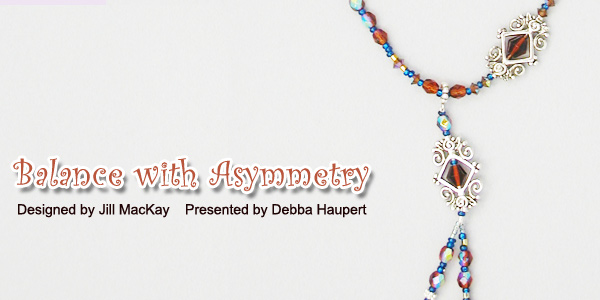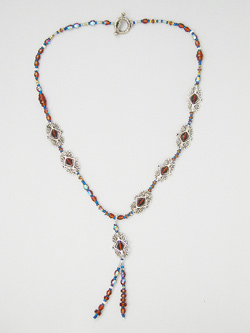
711-3
Balance with Asymmetry
Designed by Jill MacKay
Presented by Debba Haupert
Sponsor: Shipwreck Beads
For more information visit

www.shipwreckbeads.com
Material needed
From Darice (the MacKay Collection)
7 #JMC0302 Spring Spiral Bead Frame
1 #JMC0101S Spiral Toggle Clasp
From Shipwreck Beads
35 #6FC556 Topaz AB Czech Fire Polished 6mm round
7 #88FC256 Smoked Topaz Czech Fire Polished 8mm bicone
1H #8SB469 Montana blue seed beads 8/0
12 #PW392 SSP Bead Spacer Plated
20 #74CC557 Smoke Topaz AB Czech cut crystal rondell
14%B769-AB Treasure color lined dark dusty blue 14/0
10SC559-2 2 CUT TOPAZ GREEN 11/10
#10SB458 Root beer 10/0 seed beads
10 #72FC256 Faceted 6mm disc
5 #74FC256 1 faceted 8mm disc
40 Beadalon® stringing wire, bright
5 silver crimp tubes
Beadalon® Crimper tool
Beadalon® Wire cutter
1 Sterling 8mm spacer bead with ring
Tip
This necklace is asymmetrical and is also strung in a mostly random fashion.
There is one repeat pattern which happens between the bead frames but
all else is random without identifiable repeated patterns.
Stringing in random or what is called “chaos patterns” is eye-catching because the human eye will actually continue to look at something that it has to look closely at to figure out. If something is clearly patterned or organized sometimes the eyes miss the details as it will merely look and not see or study with eyes that which is recognizable or clearly definable.
The eye will simply scan over that which is similar or the same, but
when it view random and more complicated less organized field of view
it will look far more closely. The eye will study and look closely to
SEE not just look at. So in stringing randomly you are ensuring that your
jewelry designs will catch more people’s eyes!
Instructions:
1. Cut a 28” length of stringing wire.
2. Attach one end of the strand to the female end of the toggle clasp.
To do this attach string on a crimp tube then a Montana blue seed bead,
then through the small loop on the clasp, then back through the back through
the FPB and crimp tube. Snug the stringing wire tight so the glass bead
is right up to the clasp and only the string wrapping around the sliver
loop of the clasp is showing. Crimp and trim off extra stringing wire
with wire cutters.
Attaching the clasp
3. Begin stringing with a few seed beads first to ensure flexibility coming
off of the clasp, and then begin your random patterning selecting from
your beads and crystals.
4. String down 7” for the placement of the first Spring Spiral bead
frame. String through one end of the bead frame, string on one brown see
bead, one 8mm fire polished bicone and a second brown seed bead, then
out the other end of the bead frame.
How to string a Bead Frame
5. String 4 bead frames in a row in this same manner. Between each of
the bead frames you will string this pattern: a cut crystal rondell (CCR),
a Montana blue seed bead (MBSB), a CCR, AMBSB, a CCR and a BMSB.
6. Coming out the end of the fourth bead frame string ¾”
of your choice of random beads and then string on the silver spacer with
the ring. This silver spacer marks the center of the necklace.
7. Start back up the other side of the necklace by stringing 2 ¾”
of beads before coming to the placement of your first bead frame (on the
second side).
8. String bead frame as you did the others followed by one MBSB and a
CCR and another BSB: then string the second bead frame.
9. Continue stringing in a random fashion until you finish 7” more.
End the strand with three or four seed beads then string on a crimp tube,
a MBSB, string through the appropriate loop of the male end of the clasp,
then back down through the MBSB and crimp tube. Snug, crimp and trim excess
wire.
10. To make the dangle use the remaining piece of stringing wire. String
one end through the jump ring on the center silver spacer (that’s
strung on the necklace). Even the ends and hold them together, then string
on a MBSB and a 6mm topaz AB FPB and another MBSB over both strands together.
The feed both strands through the top of a spring spiral bead frame, through
one MBSB, an 8mm bicone FPB and out the other end of the bead frame and
through another MBSB and a crimp tube. Snug and crimp the tube. Do not
trim.
Make the dangle
11. Separate the strands now and string each randomly making one side
slightly longer than the other .On the project show, one is 2 ¾”
and the other is 2 1/”2 long. End each strand with a couple of the
small seed beads and then a crimp tube. Crimp and trim off excess.

Debba Haupert and Katina Forte'
| Project Images | |
 |
|